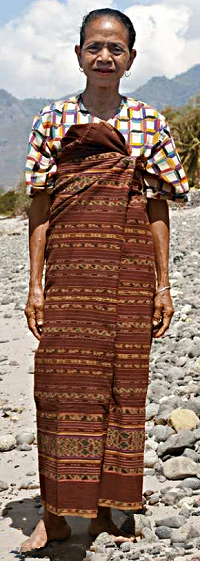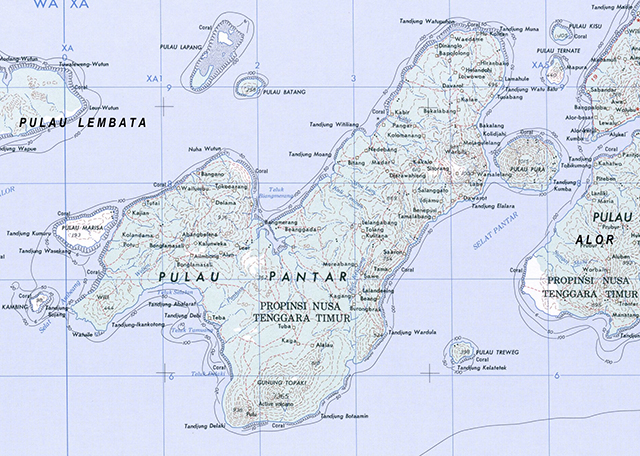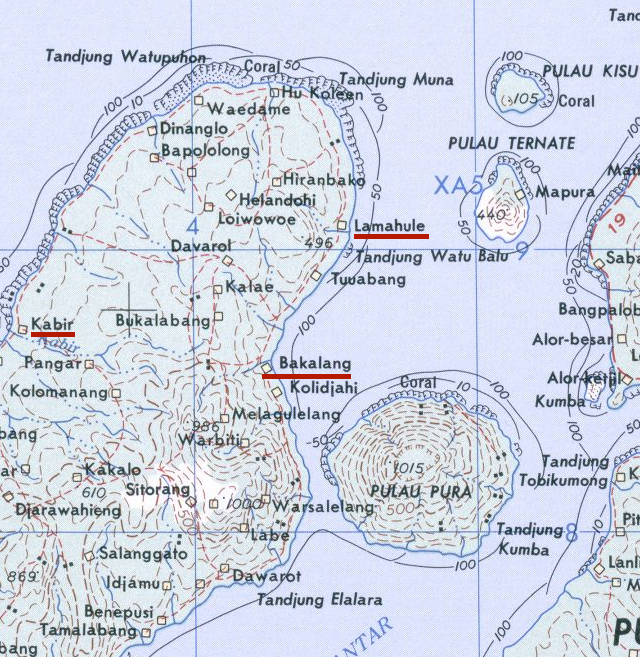Pantar, which actually does produce ikatPantar, also called Pandai, a thinly populated island in the Solor Archipelago, lies between Lembata to the east and Alor to the west. The island measures about 50 km north to south, its width varying between 10 and 30 km. The island is flat except for a hilly area in the northeast, much of it covered in grassland on which some livestock is raised. Rainfall is heavy but intermittent, and there is a marked dry season. The island economy largely relies on subsistence agriculture and fishery. Copra from coastal coconut plantations is brought to market through the Flores-based mission and lay traders. There used to exist a rich kingdom on Pantar, in Munaseli, at the Tanjung Muna, a promontory on the northern tip of the island, which had regional influence, and whose rulers were revered on account of their possession of numerous patola. Pantar was long considered barren in terms of ikat, several authors maintaining that no ikat was made here, and that whatever ikat was worn on the island was imported from Alor. We travelled to Pantar in the early 1980s and saw
One field collector who visited the island in 2013, Aja Bordeville, confirmed that she did witness weaving - albeit almost exclusively crudely designed and shoddily made cloths, but also saw a few vintage sarongs, made with hand spun cotton and vegetable dyes, dating from the 1970's or before. There are very few Pantar ikat textiles in western collections - though there may be more than is known, as they can easily misidentified as hailing from Alor or Lembata. The tonality in particular, with its dark russet background, recalls that of Lembata cloths. The two identified as 'Pantar/Alor (?)' in Khan Majlis's Woven Messages may indeed well have been imported from Alor, as they share the most common Alor lay-out with an open midfield. The few that we know with a well established Pantar provenance are marked by the seven band lay-out shared by the cloth in our collection. The preference for aquatic animals as main or only motif appears to be shared by Pantar and the small islands hemmed in between Pantar and Alor, Ternate and Buaya. It is not known when ikat weaving started on these smaller islands, which have no sweet water sources, and had hardly any permanent habitation. It presumably began in the 1990's when the apparently excellent conditions for surfing and diving began to attract tourists. We would be very happy to hear of other Pantar pieces in public or private collections, or shown in literature. Susanne Rodemeier has a very interesting section on the use of patola on Pantar. She describes that they are considered either family or clan property, and states that there are very many patola ['besonders viele'] in the extinct kingdom Munaseli at Tanjung Muna. Given the fact that the VOC was always very selective in its distribution of patola it is very hard to conceive of 'very many' having been gathered in one tiny kingdom on a ditto island, but this may be a matter of semantics. She goes on the say that in the other regions of the archipelago [Alor and the cluster of islands around it, tH] patola retain a high value not just because of their age, but also because of their rarity. For more on this see the chapter on Alor. |





 Note the promimity to Ternate. A part of western Alor is shown to the right.
Note the promimity to Ternate. A part of western Alor is shown to the right.